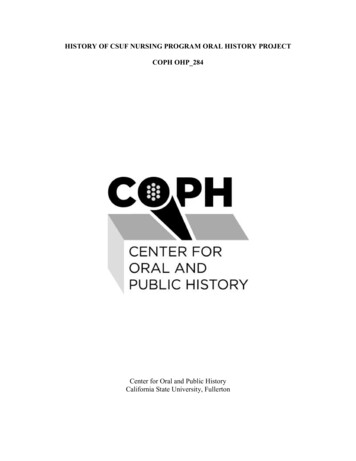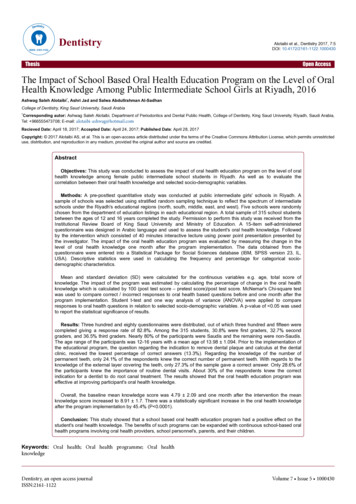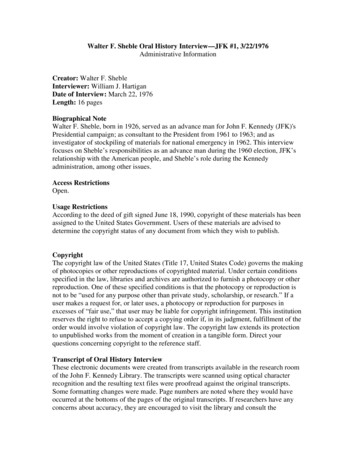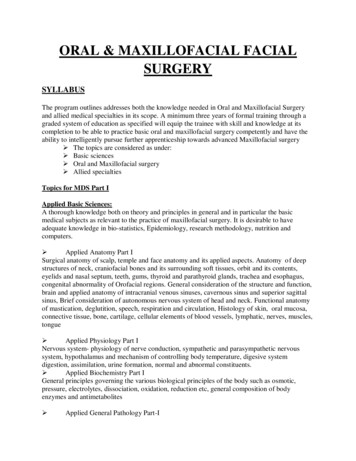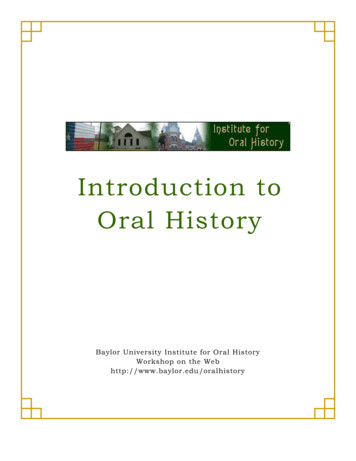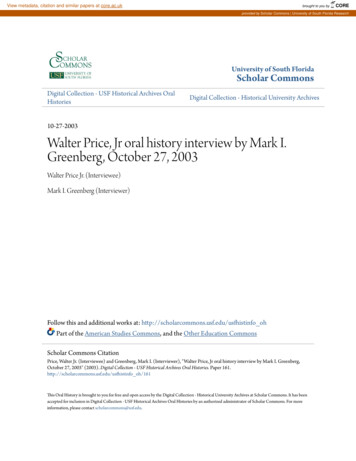
Transcription
View metadata, citation and similar papers at core.ac.ukbrought to you byCOREprovided by Scholar Commons University of South Florida ResearchUniversity of South FloridaScholar CommonsDigital Collection - USF Historical Archives OralHistoriesDigital Collection - Historical University Archives10-27-2003Walter Price, Jr oral history interview by Mark I.Greenberg, October 27, 2003Walter Price Jr. (Interviewee)Mark I. Greenberg (Interviewer)Follow this and additional works at: http://scholarcommons.usf.edu/usfhistinfo ohPart of the American Studies Commons, and the Other Education CommonsScholar Commons CitationPrice, Walter Jr. (Interviewee) and Greenberg, Mark I. (Interviewer), "Walter Price, Jr oral history interview by Mark I. Greenberg,October 27, 2003" (2003). Digital Collection - USF Historical Archives Oral Histories. Paper 161.http://scholarcommons.usf.edu/usfhistinfo oh/161This Oral History is brought to you for free and open access by the Digital Collection - Historical University Archives at Scholar Commons. It has beenaccepted for inclusion in Digital Collection - USF Historical Archives Oral Histories by an authorized administrator of Scholar Commons. For moreinformation, please contact scholarcommons@usf.edu.
COPYRIGHT NOTICEThis Oral History is copyrighted by the University of South Florida LibrariesOral History Program on behalf of the Board of Trustees of the Universityof South Florida.Copyright, 2008, University of South Florida.All rights, reserved.This oral history may be used for research, instruction, and private studyunder the provisions of the Fair Use. Fair Use is a provision of the UnitedStates Copyright Law (United States Code, Title 17, section 107), whichallows limited use of copyrighted materials under certain conditions.Fair Use limits the amount of material that may be used.For all other permissions and requests, contact the UNIVERSITY OFSOUTH FLORIDA LIBRARIES ORAL HISTORY PROGRAM at the Universityof South Florida, 4202 E. Fowler Avenue, LIB 122, Tampa, FL 33620.
USF Florida Studies CenterOral History ProgramUSF 50th History Anniversary ProjectNarrator: Walter Price, JrCurrent Position: StudentInterviewer: Mark I. GreenbergLocation of Interview: TampaCampus LibraryAbstractor: Mary E. YearyFinal Editor: Jared G. ToneyDate of Interview: October 27, 2003Editor: Danielle E. RileyDate of Edit: January 27, 2004TOPICS OF DISCUSSIONMr. Price is one of the two original “Green and Gold Guys.”Year of arrivalHe came to USF in 1999 as a student.Where did Mr. Price grow up?He grew up in a town called Tavares, which is north of Orlando. It has a population ofabout 7,000.Mr. Price’s involvement with sportsIn high school he was a swimmer, and competed on the state level. He played baseballfor thirteen years, including being on the high school varsity team. He played soccer aswell at his high school. He was involved in other extracurricular activities.Promoting athleticsHe played the bass drum in his high school band. They played beats to get the crowdpepped up. “That was the beginning taste of what I really enjoyed about football.” Forhomecoming and pep rallies, he always dressed up, painted his body, and “dyed” his hair.“I have always had that spirited, athletic craziness all my life I guess.”Mr. Price as a childHe says his parents tell him he was always doing crazy stuff as a child, always looking tomake someone laugh.Planning his post-high school yearsHe looked at Florida State University because his whole family graduated from there. Healso looked at USF because it was a closer school to his house. It was far enough awaythat if he does not have the time to go home he cannot, but if really needs to, he can.Also, his uncle went to USF, as did his father for two years, before he transferred to FSU.1
“I had some familiarity with the school itself. Plus USF had just started a football team,and it was starting to look pretty fresh.”Did the fact that USF had just begun a football program play a role in Price’s decision tocome to USF?He says it did not play a huge role in the fact that people look to institutions first foreducation purposes. “It always helps though when a university has a big athleticdepartment, not just in football, but in other sports as well. You want your school to beknown. I really didn’t want to go to a college that didn’t have too much of a sportbackground. It is something to do on the weekends. It is fun to support your school.”The graduating class from Mr. Price’s high schoolHe graduated with about 200 other seniors. Where he is from, most people, aftergraduating, go right into the working world. He says out of the 200 that graduated, aboutfifty went on to college. He believes about ten to twelve of the fifty graduates came toUSF. Out of those fifty he says probably about half actually stayed in and graduatedfrom college.First impressions of USF in 1999He lived in Gamma at the time. It was right before they renovated it. “It was a totallydifferent feeling because of all the people. But, I had been to band camps and soccercamps, so I was already used to sharing rooms and bathrooms. But, fifty people sharingone bathroom is kind of crazy. I was intimated in a way about the size of the campus. Atfirst I was a little scared driving here, and trying to find everything.” He didn’t get thefull picture until the fall semester, when he realized there was 30,000 plus students oncampus. He realized he was a number.Impersonal aspects of USF and his father’s advice leads to Mr. Price’s decision to showhis school spirit in a different wayIn high school he was very popular. He was friends with everyone. When he came tocollege his father said get an education, meet was many people as you can, and leavebeing known. He looked for that when he came to USF. He realized in the beginningthat everything was a student’s social security number, which he did not like. He felt lesslike a person and more like a statistic. He says that now USF has 41,000 students, so inmost aspects students are just a number unless they are a pretty good athlete or are knownin another way.What did Mr. Price want to study at USF?He came to study medicine. He wanted to be a pediatrician. But, when he went to ameeting about what it took to go through medical school, he decided it was not for him.“They were saying that if even if you go to school for thirteen years and pass all the tests,there still might not be a position for you. I didn’t want to take that chance of being indebt, and possibly missing out on something.” He changed his major numerous times, topolitical science, marketing, computers, and mass communications. He will graduatewith two degrees in communications. One is interpersonal communications and the otherone is public and culture communications.2
How the “Green and Gold Guys” got startedHis family has season tickets to the FSU games. He went to FSU games many timeswhere he saw two guys—the “Garnett and Gold Guys.” They painted their bodies incomplete garnet and gold, wore towels, and went up and down the stands to start noiseand get the fans involved. “It looked like it was a lot of fun.” When he came to USF in1999 there was a mix-up in who was supposed to be Mr. Price’s roommate. Brian Hopeended up as his roommate. He is exactly the same kind of person that Mr. Price is. Mr.Price asked him if he wanted to go to FSU to check out the “Garnett and Gold Guys.” Inthe fall of 1999 they went to a football game and approached the two guys. Mr. Pricetold them that he did not want to steal their image or be copycats. The guys told Mr.Price and Mr. Hope that they want people to be like them. The “Garnett and Gold Guys”want to get every university to have some guys like them.Walter Price and Brian Hope officially start a new USF tradition: the “Green and GoldGuys”Mr. Price and Mr. Hope came back to USF and painted half their bodies green and theother half gold, and wore towels. Mr. Price and Mr. Hope went to their first footballgame as college students and USF’s first game for the 1999 season as the “Green andGold Guys.”Mr. Price describes his first tailgating adventure as a college studentIt was almost about to rain. Mr. Price and Mr. Hope tried to tailgate since it was theirfirst football game as college students. Mr. Price’s friend from his high school was there.They had a propane tank, but it was up too high, and they went to light it and the lid blewup. Commenting on the tailgating adventure, which occurred before he even entered thestadium as one of the “Green and Gold Guys,” Mr. Price says, “That was how it started.It was fun.”In the fall of 1999, Mr. Price and Mr. Hope enter stadium for the first time as the “Greenand Gold Guys”Mr. Price and Mr. Hope waited until everyone went inside Raymond James. Theymissed the whole first quarter and half of the second painting their bodies and getting incostume. They went up and down the stairs and got chants going, such as “defense” and“offense.” “It was a big rush at the time. It was a lot of fun.”The first reaction of fans in stadiumWhen they entered the stadium they received a 50-50 reaction. Some people called themnames and made fun of them, and others said, “This is the coolest thing ever.” Thosereactions kept their spirits up.The “hazards” of body paintThey paint with body paint. Although the green paint says stay away from the eyes, andthe yellow paint says stay away from the lips, for every football and basketball game Mr.Price and Mr. Hope insisted on going all-out with the body paint.3
How long were they the “Green and Gold Guys?”They did this for four years. Mr. Hope graduated in May of 2003, and Mr. Price is stillgoing to school. (Graduating in December of 2003 possibly). They passed the traditiondown because USF wanted them to. They handed the reigns over to two new guys.Commitment of the “Green and Gold Guys”For four years and for every home football and basketball game they painted their bodies.They did not miss one single home game. They actually did some of the away games,such as Cincinnati versus USF for basketball, and Oklahoma Sooners versus USF forfootball. They also painted their bodies for other events, such as alumni events andhomecoming parades.How much have the “Green and Gold Guys” spent on costume supplies?In the four years that they painted their bodies they spent four or five thousand dollars onpaint and towels.Important people, including President Genshaft, become aware of the “Green and GoldGuys”He says during the fourth football game alumni came up to them wanting to get theirnumbers and talk to them. By their junior year they were pretty familiar with PresidentGenshaft on a personal level. She knows who they are. “When we were painted up shealways came up to us to see how we were doing and to tell us to keep it up. She wasalways very nice to us.” He says all of the administration knew who they were, and a lotof deans from other schools knew about them as well. Leroy Selmon was also veryfamiliar with Mr. Hope and Mr. Price. They are known in other states and have evenbeen on ESPN SportsCenter.The guys have their pictures taken often“I’m sure we are in every photo album in half of the homes in Tampa.” He says therewere some games where they didn’t even see the football game because peoplecontinuously took their pictures. “We were there for the spirit of it as well as for the kidsbecause the kids loved it. They always wanted to get their picture taken with us.” Hesays that made the kids want to come to the games, which in turn might motivate someparents to come as well.Did USF help pay for expenses?The university helped them with expenses when they went to away games. “They did alot of things for us. USF has definitely been a great school. Everyone has been sogenerous.” For the Cincinnati versus USF basketball game, USF paid for their planetickets and hotel room.The “Green and Gold Guys” never sit at the gamesAt games they did not sit down. They continuously walked around throughout thegames. “We probably walked four or five miles a game. We go up and down every stairand get people yelling. We try to get the wave going, we get defense chants, we getpeople yelling.”4
Mr. Price attends his first football game unpainted, and knows it is time to move onHe recently went to his first USF football game without being painted up, just sitting inthe stands. “It was horrible. I hated it the whole time. But, you have to move on. Yougraduate, you have to move on and start your life. You look back and say, ‘Look what Istarted.’”The “Green and Gold Guys” are proud to have paved the way for a more school spiritedatmosphereMr. Price says he looks back on his time as one of the “Green and Gold Guys” and isproud of what he started. He says now there are so many people at the games who painttheir bodies. There are probably fifteen to twenty-five people per game that paint theirbodies. “And it was just us two that started it. We were the only two that ever paintedour whole bodies. We feel that we have accomplished our goal by getting more peoplespirited. I believe that we have done a good thing by starting a tradition of spirit.”Does Mr. Hope see a growth in the athletic programs at USF?He says the basketball team is becoming more disciplined each year. He thinks the newcoach can take the basketball team to the next level. Referring to the USF basketballteam, Mr. Hope says, “We have always been right there, that one game closer to beingbetter. I think we will do it.”Progress of the USF basketball team“I think the basketball team has come a long way. We have four retired jerseys in thegym.”Progress of the USF football team“The football team is just unbelievable. The amount of growth it has done inperformance is unbelievable. It started in 1997. We just got a bid to be in the Big EastConference. This is our first year in a conference. The progression in football istremendous.” He says what the football program has accomplished in its six years ofexistence is unbelievable. He says it has come a long way in a short amount of time.Other schools have taken a lot longer to get where they are. He says one day USF willhave a sell-out crowd for its football games.Progress of USF’s athletic teams in general“Every athletic team we have is just getting better each year.”“Spirit” organizationThere was an organization at USF at the time called Spirit. The members elected Mr.Hope and Mr. Price as president and vice president of the club. Mr. Price says the clubinspired other people. The club’s activities included getting people to have school spiritat events, throwing out little footballs and pom-poms at games, and trying to get morepeople to attend games.The support of Mr. Price’s parents5
They have always supported him. “They have never told me I couldn’t do something.”They bought a lot of their paint. “They came to all the games. They loved it.” Like hisfather told him, “Don’t leave as just a number, leave being known.” He did that and hisfather was proud of him. They always loved the idea of the “Green and Gold Guys.”“They thought it was the greatest thing.” They wanted Mr. Price to learn and have agood time.The academic side of thingsHe changed his major seven times. He has taken many different classes, from childpsychology to marketing. He says with his communication degree he can hopefully get ajob anywhere. He has emphases in interpersonal communications, group presentations,and human persuasion.Mr. Price’s career goal, and how his degree will help himHis father owns a real estate business, and would like Mr. Price to open up an office inhis name in Tampa. Mr. Price says communication is very important in real estate. Hisfather does real estate appraisal, which is not selling the house, but rather appraising thehouse. Mr. Price says appraisal involves talking to banks and other people. Plus inowning one’s own business, communication is important. His father did not need adegree either but he got two degrees from FSU, in real estate and business. “I thinkbecause of that he gets a lot more business.” He believes a college degree will help him.Plus he says there are risks involved in running one’s own business. If somethinghappened, Mr. Price always has his degree to fall back on.Mr. Price on why they became the “Green and Gold Guys”They did it because they did not want to just sit at football games. They did not do it toget recognition or fame. He says if the games had sell-out crowds, it would be different,but since they were not sell-out crowds, they just did not want to sit there.Choosing the successorsThey did not want the “Green and Gold Guys” to disappear. Mr. Price decided he wantedit to become a tradition. Mr. Hope thought that was a good idea. They startednetworking more with the alumni center. “Before you know it, they were on us aboutfinding two new people.” Debbie Lum, who works at the Alumni Center, wanted them topick two guys. They started looking for two new guys. They held a meeting, where onlytwo people showed up. They kept one guy. “It was a hard decision. We had to makesure we found two people who would go to every game, and stick it out. They had tohave the money for paint. It had to be a tradition they were proud of and wanted to help.”The successorsJames and Bishop became the successors in the fall of 2003. The two guys had some trialruns the year before. “We are so glad we picked them. They are the two best guys wecould have picked for the job. They are always there at the games. They are bothsophomores so they will be here for two more years at least.”6
A scholarship is started for the “Green and Gold Guys”The alumni center, notably Debbie Lum, began a scholarship after Mr. Price and Mr.Hope. Each year they give the two “Green and Gold Guys” 500 to buy supplies.What does Mr. Hope do now since he has graduated?Mr. Hope now sells trucks at Gator Ford in Tampa. “He is really good at it.”Mr. Price talks about Mr. Hope“He is a very good golfer. He is a very go-with-the-flow guy. He is crazy and fun. He iseverything I am. We are like two peas in a pod. We were a perfect match for the “Greenand Gold Guys” because we both liked to have fun and didn’t mind painting up.”Logistics of paintingHalf the body is green and half the body is gold. “I believe it was always left side yellowand right side green, except for the hair.” Mr. Hope always had gold hair and wore thegold towel. Mr. Price always had green hair and wore the green towel.Where did they paint their bodies before games?For the first year they painted up in the parking lot at Raymond James. After that theyreceived their own dressing room at the stadium. They had their own access passes.Their room was right next door to the USF football locker room. They always finishedpainting right when the team walked out. So they gave them all high fives. “The playersloved us.”Mr. Price comments on the support they received from the football teamHe says for the most part, almost every one on the team, and the coaching staff, isgenuinely nice to everyone on campus. The football players always clapped for them.How long did it take to paint up before a game or an event?The first two years it took an hour and a half to get the paint on. By the time theygraduated they could get ready for a game in fifteen minutes. Mr. Price says the progressin getting-ready time came with a lot of practice.How did they put the paint on?They put the paint on with their hands. They helped each other with getting the colordividing line down their backs correct.How much paint did they use?It took about sixteen tubes of paint to do one body, front and back.Who provided the paint?They got the paint from Party City. They gave them a discount because they bought somuch paint each time they were there, and thus giving the store a lot of business. Themanager gave them a twenty percent discount. The manager only carried the paint duringHalloween, but he went out of his way to special order it for them.7
How did they ride home after games?They used their cars to get to and from every game or event. Every other game theyswitched off whose car it would be. They had the hardest time trying to figure out whatto sit on. One day they happened to be transferring a couch from Mr. Hope’s oldapartment to a new one in Brandon. A clear shower curtain covered the coach. It flewoff as they traveled down I-75. Mr. Price slammed on the brakes, and ran across theinterstate to get the curtain. He put it in the car. Mr. Price thought, “You know what thisis what we will use to sit on.” They decided to use that after every game because it didnot matter if paint got on it. They wore T-shirts as well. They wrapped the whole carwith a shower curtain so they would not get any paint on anything. However, Mr. Pricesays there are still traces of paint in his car. He says the whole back of his seat is all gold.He says they could not wear a seatbelt on the way home from games, so they droveslowly. Law enforcement never stopped them. Mr. Price says people did yell and honktheir horns at them on the way home from games.The estimated number of times they paintedHe says they probably painted up about 200 times.How long did it take to get the paint off?It took about an hour to get the paint off.Where did they take the paint off?Mr. Price lived in Fontana Hall for two and a half years, and Mr. Hope lived there for oneand a half years, so they used the bathroom in their rooms. The last two years, whenneither lived there, Fontana Hall gave them a private room in which to shower. “Wenever had to worry about ruining our apartments.” The best way to clean the shower waswith WD-40, which caused the paint to run off the shower walls. Mr. Price says theyreally appreciated Fontana Hall letting them have the room for two years. “It wasextremely nice of them, they didn’t have to do that.”People who paint up just for televised gamesHe says one sad thing is that a lot of people just paint their faces when a game will benationally televised, but Mr. Price and Mr. Hope did it for every game.Mr. Price comments on the appreciation they have received from othersHe said it did feel good to have the most important people, such as President Genshaft,coming up to them and thanking them. “That is the greatest joy.” During Mr. Hope’ssenior year they did a homecoming float, which cost 1,100. They had 1,300 donated tothem. “That really showed the appreciation for who we were and what we did.”What really stands out to Mr. Price about his time as one of the “Green and GoldGuys?”Mr. Price says the most special part was the kids. Kids always came up to them wantingtheir picture taken with them or wanting hugs. “It’s a good feeling to have someoneenjoy you that much.”8
The “fame” of the “Green and Gold Guys”Although no one officially interviewed them, Mr. Hope and Mr. Price appeared on ESPNSportsCenter, and on a lot of local news channels. They had their picture taken with DickVital. They were sort of interviewed for a UF versus USF basketball game, but they werenot painted up because they spent the night at the Sun Dome.Sleeping outside the Sun Dome for UF vs. USF in basketballThe night before UF played USF the “whole school” camped out beside the Sun Dome.It was an all-night pep rally. Mr. Price says it was raining, but no one cared. Everyonewas having fun. They next morning they woke up and saw news cameras everywhere.Mr. Price comments on the show of school sprit just for big games, such UF vs. USFAlthough Mr. Price is glad to see school spirit, he says the one thing that sort of upsethim was that the huge show of school spirit was just for the Gator game. There wasalmost a sold-out crowd for the game. “It was so loud. It was amazing. If we could justget that for every basketball and football game.” His dream is to see Raymond Jamessold out for a Bulls football game, which means 62,000 people would be in attendance.“I think it will happen.”Mr. Price wants to begin a “Green and Gold Guys” FoundationHe talked to Debbie Lum about starting a group at the Alumni Center, which would talkabout traditions. They would go to high schools and do presentations. Also, Mr. Hopeand Mr. Price would like to be in charge of a “Green and Gold Guys” Foundation, whichwould make sure that there are two “Green and Gold Guys” every year.When he leaves USF, what will he take with him?Mr. Price says he has learned the ability to think on the spot and solve problems quickly.He will leave USF knowing that he had a great time, and that he will be remembered nomatter what. For the rest of his life, USF will know who Walter Price and Brian Hopeare. “We made a stand. I will have the joy of knowing that I will have made my parentsextremely happy by doing everything they asked me to do to graduate—get an education,meet as many people as [I] can, and get known.” He says the joy he will see on hisparents face when he graduates will be something he will always remember. “This is agreat school. I would love for my kid to go here. College has definitely been the bestfour years of my life.”What would Mr. Price tell a prospective college student about USF?He would say that one should never base his or her reason for going to a particularuniversity on its football team. He would say, “Why would you want to join an oldtradition, when you could start a new one?” He would say that a school such as FSUalready has enough people there. They should go to a school that needs more traditionand spirit. “We need to get USF like UF and FSU.” He says he would never say thatUSF is the best school in Florida. “You need to go where you want to go for your fieldof study. But, you need to realize that USF has a lot of fields of study plus the universityis trying to start a tradition with football.” He says the sad thing is that a lot of peoplethink about a school’s football team when they are choosing a university. He says9
football teams are great. “It’s an American sport. That’s what college is about—going tothe football games and having that beer with your buddy. But, you have to realize toothat you have to pick a school that has a good education background. You don’t want togo to some school just because they have a good football team, and not learn anythingexcept for what play was just run. You don’t want to graduate knowing the plays infootball.” That is what Mr. Price would say to a prospective college student.Mr. Price really appreciated doing the interview.End of Interview10
Mr. Price's involvement with sports In high school he was a swimmer, and competed on the state level. He played baseball for thirteen years, including being on the high school varsity team. He played soccer as well at his high school. He was involved in other extracurricular activities. Promoting athletics
